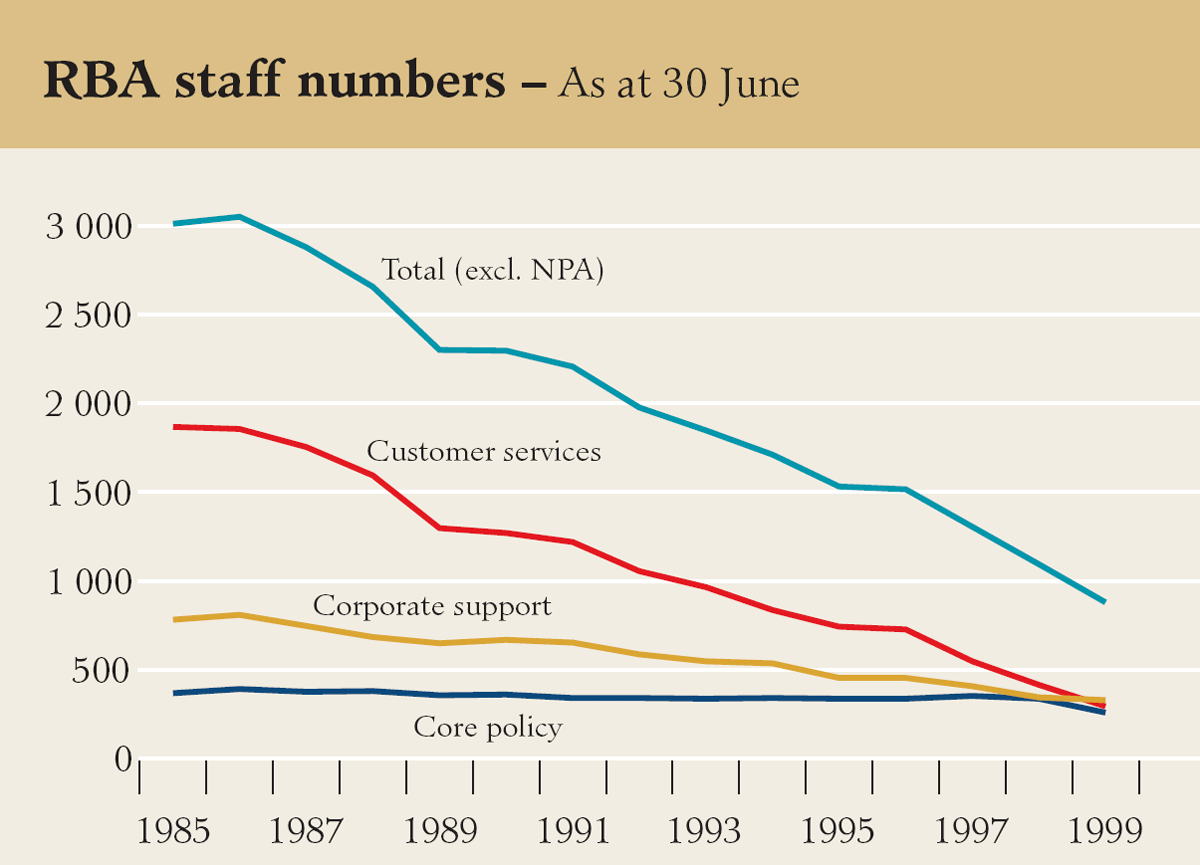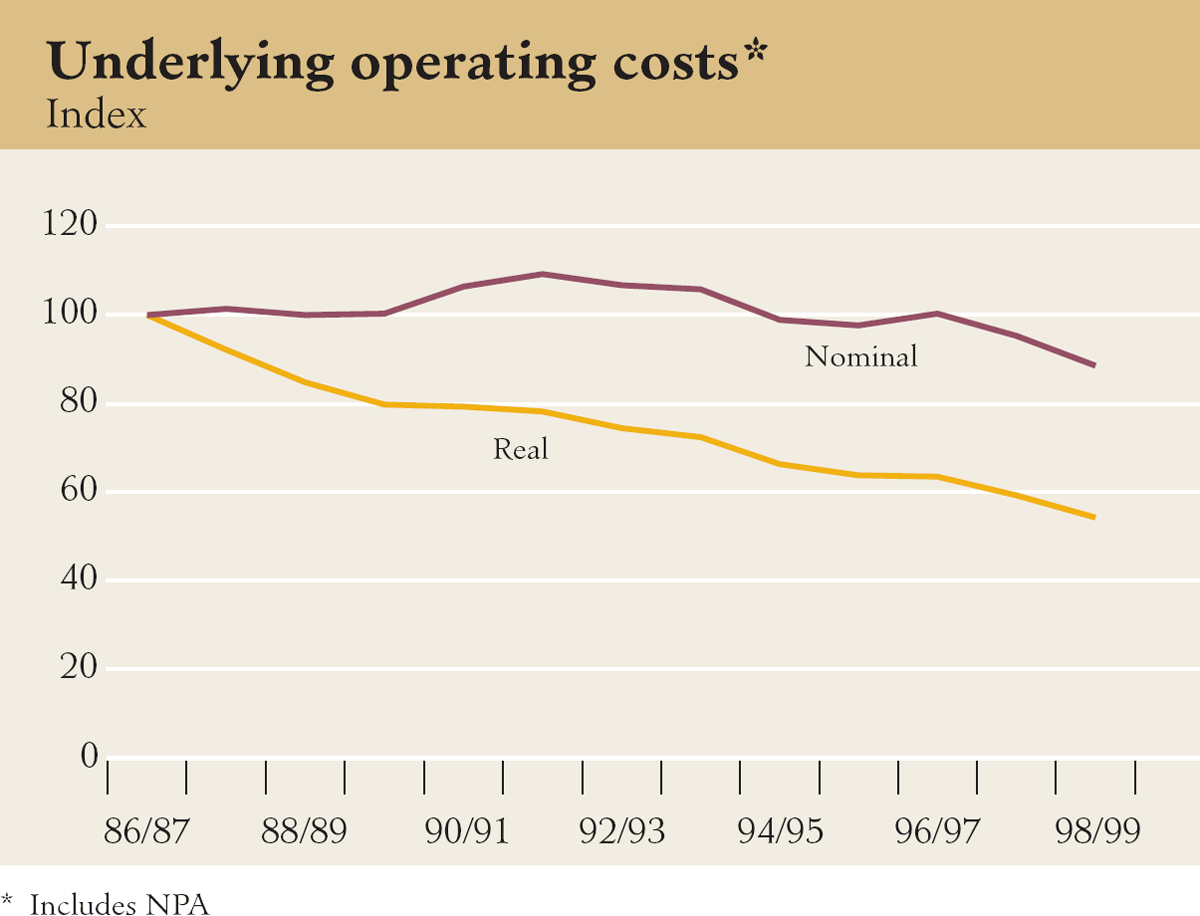Reserve Bank of Australia Annual Report – 1999 Management of the Bank
This was the first year that the Bank had operated under the new administrative framework introduced in mid 1998. An important part of this had been the restructuring of the Financial Institutions Group to assist in the implementation of the Bank's responsibilities under Australia's new system of financial regulation. This had involved the abolition of Bank Supervision Department on 1 July 1998 with the transfer of most of its 65 staff to the Australian Prudential Regulation Authority (APRA) and, in its place, the creation of a smaller System Stability Department to support the Reserve Bank's role in protecting the stability of the financial system. This provided a suitable opportunity for the Bank to bolster its capacity for research in the areas of financial and systemic risk. The Bank also responded to its enhanced powers in the payments system, by restructuring the former Financial System Department as the renamed Payments Policy Department, again with a more focused policy function.
For the Business Services Group, an important achievement this year was the bedding-down of the new Payments Settlements Department established to manage and operate the RTGS system, which became fully operational in June 1998. While this created a number of new positions, staffing numbers in the Group as a whole fell significantly over the year as steps taken to improve the efficiency of cheque-clearing and cash-handling operations continued to flow through to staffing levels. The new cash distribution arrangements that were introduced in July 1998, for example, ended the Bank's specialised currency distribution service for individual bank branches in metropolitan areas; and in October cash-processing and distribution services were discontinued altogether in Canberra and Hobart. With the loss of the Tasmanian banking business, the existence of a Hobart branch could not be justified and it was closed on 30 October 1998. Two other government customers, Western Australia and the Australian Capital Territory, have recently gone to tender and selected other banks to conduct their banking business. In response, staff numbers in Perth are being reduced from 35 to 14. In Canberra, the outcome is less certain as the branch is fully employed in the tasks associated with the devolution of the Commonwealth's banking business from 1 July 1999.
As a result of these changes, in 1998/99 staff numbers fell below 1,000 for the first time, to reach 878 by end June, a fall of nearly 20 per cent over the year.
On the remuneration front, staff received a 4.4 per cent increase in salary in July 1998, which was the second tranche payment provided for in the 1997/98 productivity bargaining agreement which was negotiated in 1997. A new productivity bargaining agreement was concluded in April 1999 covering the calendar years 1999–2000. The agreement provides for two annual salary increases of 3.5 per cent with the initial increase effective from July this year. In return, staff agreed to a number of productivity-related changes to employment conditions, including a streamlining of staff selection and appeal procedures. These will continue to emphasise the principles of merit selection to all positions in the Bank with a strengthening of the existing panel process, but without the avenue of appeal to a separate Promotions Board of Review.

The reduction in staff numbers during the course of 1998/99 resulted in a fall in staff costs; these costs have declined by around 26 per cent over the past two years. Outsourcing arrangements have contributed to this decline but were partly offset by payments included in other costs, including for services such as guards and cheque-processing now provided by outside suppliers. In 1998/99, other costs stayed around the higher level reached the previous year; costs associated with the operation of the real-time gross settlement system and the establishment of Payments Settlements Department were offset by lower premises and equipment costs for note production. Overall, underlying operating costs (excluding redundancies and certain other one-off items) fell further in 1998/99, to be 19 per cent lower than their peak in 1991/92. In real terms, the decline has been even more marked.
| 1991/92 | 1992/93 | 1993/94 | 1994/95 | 1995/96 | 1996/97 | 1997/98 | 1998/99 | |
|---|---|---|---|---|---|---|---|---|
| Staff costs# | 116.4 | 112.3 | 111.7 | 108.0 | 106.6 | 111.9 | 93.8 | 82.6 |
| Other costs* | 68.6 | 68.7 | 67.7 | 59.6 | 58.8 | 58.0 | 67.7 | 67.5 |
| Underlying operating costs |
185.0 | 181.0 | 179.4 | 167.6 | 165.4 | 169.9 | 161.5 | 150.1 |
| Cost of redundancies | 18.8 | 2.7 | 9.8 | 18.1 | 1.3 | 12.9 | 29.7 | 18.4 |
| (a) Includes NPA # Excludes redundancies and, from 1994/95, additional charges to comply with accounting standard AAS30 * Includes premises and equipment (including depreciation), but excludes IMF maintenance of value payment |
||||||||

In the table on page 53, 1997/98 figures for other costs and underlying operating costs have been revised down by $13.7 million from those shown in last year's Annual Report, due to a change in accounting treatment. Previously, operating cost figures included certain outlays which were exactly matched by revenues; these ‘pass through’ expenses have now been netted against their corresponding revenues. The expenditures and revenues concerned are those associated with the management of the Australian Taxation Office's Billpay services and with note substrate purchased for subsequent export. Figures prior to 1997/98 were not affected by this change in approach.
Changes in the distribution of operating costs reflect changes in the Reserve Bank's activities in 1998/99. The share of operating costs associated with financial system surveillance declined due to the move of bank supervision responsibilities to APRA. The share of costs absorbed by note distribution fell because of the Bank's exit from retail cash distribution; these costs represented 24 per cent of operating costs two years ago compared to 15 per cent in the latest year. With these declines, monetary policy accounted for an increased share of costs, while the rise in settlement costs was associated with the real-time gross settlement system and the new Payments Settlements Department.
| Monetary policy | Financial system surveillance |
Note distribution | Note purchases | Banking and registry | Settlement | |
|---|---|---|---|---|---|---|
| 1996/97 | 23 | 11 | 24 | 19 | 18 | 5 |
| 1997/98 | 24 | 11 | 18 | 22 | 18 | 7 |
| 1998/99 | 27 | 6 | 15 | 24 | 17 | 11 |
| (a) Excludes NPA | ||||||
The Reserve Bank continues to support staff undertaking further development. Five staff are currently studying full-time under the Bank's Post-Graduate Study Award Scheme, four of them at overseas universities. Over the year, the Bank also provided financial support to 93 staff undertaking part-time tertiary studies in Australia.
Work experience has again been provided to a number of students and support has continued to be provided for the employment of trainees through the Reserve Bank New Apprenticeship and Training System Agreement 1999.
The Reserve Bank holds a licence to self-insure its workers' compensation claims. These have continued to decline reflecting both falling staff numbers and efforts to raise staff awareness of health and safety issues and involvement in hazard reduction. While claim numbers have decreased, their average cost has risen because of a small number of complex ongoing claims. Self-insurance costs continued to be lower than premiums charged by Comcare.